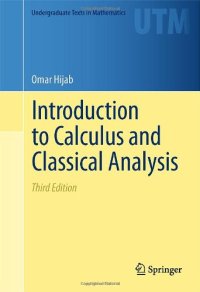
Ebook: Introduction to calculus and classical analysis
Author: Omar Hijab (auth.)
- Tags: Approximations and Expansions, Sequences Series Summability, Special Functions, Combinatorics
- Series: Undergraduate Texts in Mathematics
- Year: 2011
- Publisher: Springer-Verlag New York
- Edition: 3
- Language: English
- pdf
This text is intended for an honors calculus course or for an introduction to analysis. Involving rigorous analysis, computational dexterity, and a breadth of applications, it is ideal for undergraduate majors. This third edition includes corrections as well as some additional material.
Some features of the text:
* The text is completely self-contained and starts with the real number axioms;
* The integral is defined as the area under the graph, while the area is defined for every subset of the plane;
* There is a heavy emphasis on computational problems, from the high-school quadratic formula to the formula for the derivative of the zeta function at zero;
* There are applications from many parts of analysis, e.g., convexity, the Cantor set, continued fractions, the AGM, the theta and zeta functions, transcendental numbers, the Bessel and gamma functions, and many more;
* Traditionally transcendentally presented material, such as infinite products, the Bernoulli series, and the zeta functional equation, is developed over the reals;
* There are 385 problems with all the solutions at the back of the text.
Review from the first edition:
"This is a very intriguing, decidedly unusual, and very satisfying treatment of calculus and introductory analysis. It's full of quirky little approaches to standard topics that make one wonder over and over again, 'Why is it never done like this?'"
-John Allen Paulos, author of Innumeracy and A Mathematician Reads the Newspaper
This text is intended for an honors calculus course or for an introduction to analysis. Involving rigorous analysis, computational dexterity, and a breadth of applications, it is ideal for undergraduate majors. This third edition includes corrections as well as some additional material.Some features of the text include: The text is completely self-contained and starts with the real number axioms; The integral is defined as the area under the graph, while the area is defined for every subset of the plane; There is a heavy emphasis on computational problems, from the high-school quadratic formula to the formula for the derivative of the zeta function at zero; There are applications from many parts of analysis, e.g., convexity, the Cantor set, continued fractions, the AGM, the theta and zeta functions, transcendental numbers, the Bessel and gamma functions, and many more; Traditionally transcendentally presented material, such as infinite products, the Bernoulli series, and the zeta functional equation, is developed over the reals; and There are 385 problems with all the solutions at the back of the text.